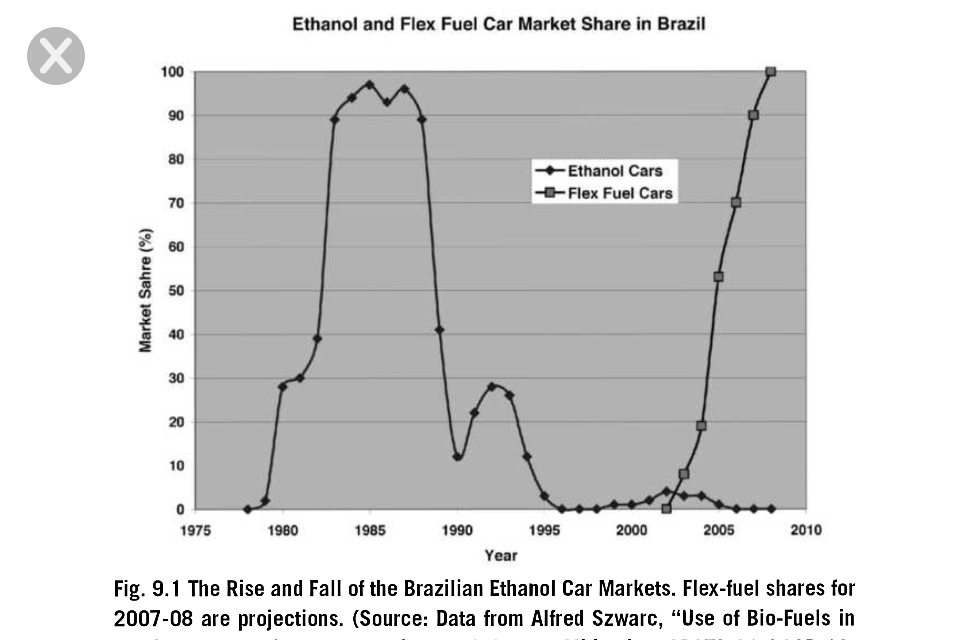4. Flex Fueled and Neat Ethanol Vehicles in the US, and the Vehicle Options Around the World

There are now 14,000,000 Flex Fueled Vehicles on the U.S. roads. They are a legacy from the 1980s, when the California Methanol Project was being run. That project initially used vehicles that could only use 100% methanol. These carbureted engines ran fine (after a little tweaking) but the users had a hard time finding the methanol to fuel them. Somewhere in the early stages of the program, Roberta Nichols, a Ford engineer came up with the Flex Fuel Vehicle idea that we still have. She and Ford determined that an engine could be made to run effectively on any combination of methanol and gasoline up to 85% methanol. This dramatically relaxed the need to find a methanol filling station, and the California project went on for 15 years and was a success. We talk about this elsewhere. But the consequence of Roberta's engineering idea easily carried over to using ethanol fuel, so E85 Flex Fueled vehicles became the standard for renewable alternative ethanol fuel, and, of course are now being built in the millions, on the same philosophical basis.
So what's the problem? The problem that now presents itself with these vehicles is that, when they were conceived in the 1980s, gasoline was very inexpensive and the issue of using the alcohol fuel efficiency was not of concern. The issue they were designed around was that alcohols (and methanol was the alcohol of choice then) emit much lower pollution. California, in its efforts to lower its serious pollution problems simply wanted to decrease the amount of gasoline used to lower pollution levels. Things have change since then. We have doubled our population since 1980. We now import 50% of the oil we use at great cost to our treasure, and our air is still very dirty. Our needs now are to get off the oil, to reduce our pollution, and to lower the threatening green house gases associated with gasoline production and use. So as you will see the current Flex Fueled vehicles are dinosaurs that need a make over.
We will start by talking about research work that has been done by our own EPA to show the potential of running an internal combustion engine on alcohols. They have tested both ethanol and methanol, but we will only discuss their ethanol results in this Chapter. The methanol results will be shown in the Methanol Section (#4). We then show countries and companies where these laboratory results have been put into practice.
First to Brazil, where the make over has been made, and very extensively being used. Then move onto some European car and engine makers that have seen the light, and are making engines that take full accord of the value of ethanol, and then onto an American Company that is also working to optimize the alcohol engine.
4.1. What can an ethanol engine do?
In the 1990s the EPA under the leadership of Matt Brusstar showed that E100 would result in peak Brake Efficiencies of over 41%. This is 25% better than the best gasoline engines.

Figure 1. Performance map of the 1.9L VW TDI Diesel engine running on 100% ethanol (E100).
Furthermore, by comparing this ethanol based performance map for the modified diesel engine with that of the engine running on diesel fuel (for which it was designed), shown below, we can see that the ethanol is all that is needed to run diesel type engines with equal or greater efficiencies and therefore potentially greater performance. (Of course, the diesel injectors must be replaced by spark plugs.)

And perhaps even more impressive, and maybe just as important are the results showing that 30% ethanol (E30) would result in efficiencies of over 38% in the same engine. Thus, E30 results in a very large improvement in engine performance.

Figure 3. Performance map of the 1.9L VW TDI Diesel engine running on 30% ethanol (E30).
More recently, Boretti 2010 "ANALYSIS OF DESIGN OF PURE ETHANOL ENGINES" shows once again the much greater Brake Engine Efficiency obtainable using 100% ethanol.
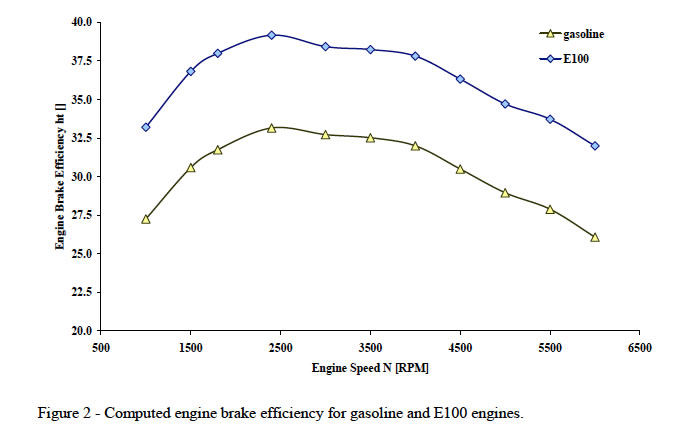
4.2. Flex fueled vehicles in Brazil
International auto manufactures have an extensive line of total flex fueled vehicles from which Brazilians can choose. Below we show VW's 2006 lineup. However, GM, Ford, Fiat, and many French and Japanese makers also provide choice.

4.2.1. Ethanol usage history in Brazil
Pure ethanol engines have been very popular in Brazil in the 80s. Brazil has been the pioneering country in the use of ethanol as a road transport fuel, starting its experience in between the two world wars. Sugar cane has been one of the main resources of Brazil since the 1500s, and sugar cane crops are the basis for ethanol production in Brazil. In the 70s, increased oil prices convinced the Brazilian government to launch the Pro-alcohol program to help reduce the country's dependence on oil replacing gasoline with ethanol made from sugar. In the early 80s almost all cars sold in Brazil ran on ethanol. As oil prices dropped in the latest 80s, the Brazilian government suddenly decreased support for ethanol production, and production volumes stagnated despite the fact that demand remained strong. A serious supply crisis occurred in 1989, when drivers where not able to find the pure ethanol fuel required to run the not flex-fuel cars. The supply crisis and the subsequent loss of consumer’s confidence in pure ethanol fueled cars plus the oil prices affordable over again plunged the popularity of ethanol-powered cars. When oil prices returned high, ethanol in Brazil rebounded, but this time car manufacturers designed flex-fuel cars powered by any mixture of gasoline and ethanol, allowing the driver to choose whichever fuel was cheaper or more easily available. The additional benefits in terms of reduction of CO2 production and use of fossil fuels and a more mature, environmentally friendly and sustainable ethanol industry may renew the scope of pure ethanol engines having efficiencies much better than gasoline.
We quantify the Ethanol market in Brazil in the charts below As noted it has undergone two important and interesting stages. The first stage vehicles were ethanol only and were very successful until there was the drop in oil prices and government support. In the second stage, with the advent of flex-fueled vehicles, the market has taken off again. This time almost every new car in Brazil is a Flex Fueled one.
In the plot below, we see the dramatic effect of using ethanol on Brazil's oil dependence. Over two decades it went from matching the US percent imported to essentially importing ZERO oil.
The introduction of flex-fuel cars in 2003 revived hydrous ethanol consumption in Brazil. Owners of these cars may opt to run them on any fuel combination—from 100 percent ethanol to 100 percent gasoline (all gasoline in Brazil is already blended 20 to 25 percent ethanol) based on prices at the retail level. Brazil’s vehicle fleet totals 26 million units (about 10 percent of the U.S. fleet size), and flex-fuel cars (about 11 million vehicles) account for 60 percent of total ethanol demand in the country. About 87 percent of new cars and light trucks sold in Brazil are flex-fuel; the remainder (trucks4 and buses) run on diesel (ANFAVEA, 2009). Brazil’s hydrous ethanol consumption increased an impressive 27 percent annually in 2003-09. Over the same period, anhydrous ethanol consumption decreased 2 percent per year as the lower gasoline demand was not sufficiently offset by increases in the blending rate of ethanol in gasoline. In 2009, hydrous ethanol consumption for fuel reached a high of 16.3 billion liters and anhydrous ethanol consumption reached 6.4 billion liters (table 6). Government policies have played an important role in increasing the demand for hydrous ethanol and for increasing Brazil’s flex-fuel vehicle fleet.
4.3. Flex Fueled vehicles in Europe
Saab had taken the lead. However, when its management let its engineers move to fast for GM, its owner, it was left to die.
4.3.1. Saab E-85 'Biopower' 9-3 and 9-5
By optimizing an E85 Flex Fueled engine, Saab was able to increase the horse power from 150 to 180.
4.3.2. Saab E-100 'Biopower' 100
In 2007 Saab showed a doubling of horsepower using 100% ethanol in a modified 4 cylinder 2 liter engine made by GM. They
4.3.3. Ricardo
Engines are now being built by Ricardo Engine Consulting that can use these advantages of ethanol. Ricardo showcased its 3.2-liter V-6 Ethanol-Boosted Direct Injection (EBDI) prototype, which is capable of operating on gasoline or up to 100 percent ethanol. The goal of the new engine was to match the performance of a 6.6-liter turbo-diesel in power, while bettering it in fuel economy. "The EBDI engine is focused on delivering optimal performance from any gasoline blend based on octane and/or ethanol content. The engine has overachieved its low speed torque performance goals on both ethanol and gasoline," said Rod Beazley, Vice President of Spark Ignited Engines at Ricardo. "This represents an archetypal change when considering the low speed torque output of the gasoline engine compared to the diesel engine - in actual fact the gasoline engine far outperforms the diesel in terms of specific torque performance."
When you do the math, the Ricardo V-6 out-torques the 6.6-liter turbo diesel Duramax. Fuel economy should match or exceed (by 10-percent) the Duramax and other current medium- and light-duty diesel engines.
For areas of the country where ethanol is widely available, Ricardo's engine improves the efficiency when running on that fuel. Instead of a mileage decrease (compared to gasoline) of nearly 33-percent, their engine is only 15-20 percent less efficient with running on ethanol. This more closely corresponds to the cost of ethanol compared to gasoline, while providing considerably more power.
Ricardo's engine also takes advantage of ethanol's higher octane rating, and the total Brake Mean Effective Pressure (BMEP, a measure that compares the power output of dissimilar engines) on ethanol is 35 bar compared to 30 bar running on gasoline. Many of today's production car and light-truck engines achieve a BMEP of 18-22 bar, with Porsche's latest flat-six turbo engines achieving a high mark of 25 bar.
Another factor is cost. Compared to engines such as the Duramax, the Ricardo engine should be significantly less expensive to produce because the fuel injection system is less complex (it runs at 200 bar of pressure, compared to 2000+ for diesels with direct injection). Additionally, the EBDI's exhaust system requires only a three-way catalyst, a solution that is far less complex than the filters and after treatment needed by diesels to meet new diesel emissions standards.
In terms of dollars, the aforementioned differences currently account for $3,700-5,000 in added cost compared to components that can be used on an EBDI engine.
Ricardo is using its prototype to focus on some of this country's biggest fuel consumers. It makes sense to address the biggest consumers of fuel when introducing a technology that helps reduce fuel consumption. When fleet owners do the math, saving 10-percent on fuel for a vehicle that gets only 8 mpg over a yearly driving cycle of 40,000 miles is almost four times more valuable than increasing the fuel economy of a vehicle getting 30 mpg the same 10 percent if both are driven the same annual mileage. This explains the interest in improving the efficiency for medium- and heavy-duty trucks.
Luke Cruff, Ricardo Chief Engineer said, "This engine uses or modifies existing technology to deliver a better solution." The Ricardo team foresees that a production version of their EBDI engine could be introduced on a production vehicle within 3-5 years. The technology is scaleable, so the technology that makes EBDI work can be applied to any size gasoline engine and achieve similar performance results.
The video below has Rod Beazley describe the EBDI (Extreme Boosted Direct Injection) engine, and what it can do at the 2010 Washington Auto show.
An interesting aspect of the Ricardo engine is that to be competitive in terms of power with current large-displacement diesel engines, such as GM's 6.6-liter Duramax (665 lb-ft of torque), the Ricardo engine runs the engine's twin turbos on-boost at nearly all engine speeds. Currently available engines such as the turbocharged and DI GM 2.0-liter Ecotec and Ford's 3.5-liter EcoBoost engines, only run turbo boost under heavier loads.
4.3.4. Ricardo's President has a vision of the the future.
"We think this could replace conventional engines, and could even replace diesels," says Kent Niederhofer, president of Ricardo.
It is important to realize that this statement is coming from a source that realy understands engines - as well as anybody in the world!
This is also the view of the Institute for Energy Resourcefulness. We believe that diesel engines are going to go the way of the dinosaur. It will take the public to understand and see that it is possible -- as Ricardo is trying to do. Diesel engines, with their particlulates and their NOx are a monumental stain on our world. They are deemed necessary because they looked to be the most financially viable method of hauling the loads we have assigned to them.
One of the informal goals of the Institute is to rid the world of diesel engines. All Internal Combustion Engines will be run better on alcohols.
4.4 Flex Fueled Vehicles in the U.S.
Roberta Nichols of Ford Motor Company developed the concept of a car that could run on a combination of gasoline and alcohol. She and her team build cars that could run on any mixture of ethanol or methanol up to a total of 85% of these alcohols with the remainder being gasoline.
Basically the parts changes to modern Flex-Fueled vehicles involve the following:
One is the elimination of bare magnesium, aluminum, and rubber parts in the fuel system. Another is that fuel pumps must be capable of operating with electrically conductive ethanol instead of non-conducting dielectric gasoline fuel. Fuel-injection control systems have a wider range of pulse widths to inject approximately 34% more fuel. Stainless steel fuel lines, sometimes lined with plastic, and stainless-steel fuel tanks in place of terne fuel tanks are used. In some cases, FFVs use acid-neutralizing motor oil. For vehicles with fuel-tank-mounted fuel pumps, additional differences to prevent arcing, as well as flame arrestors positioned in the tank's fill pipe, are also sometimes used.
Pictorially here is where the changes are:
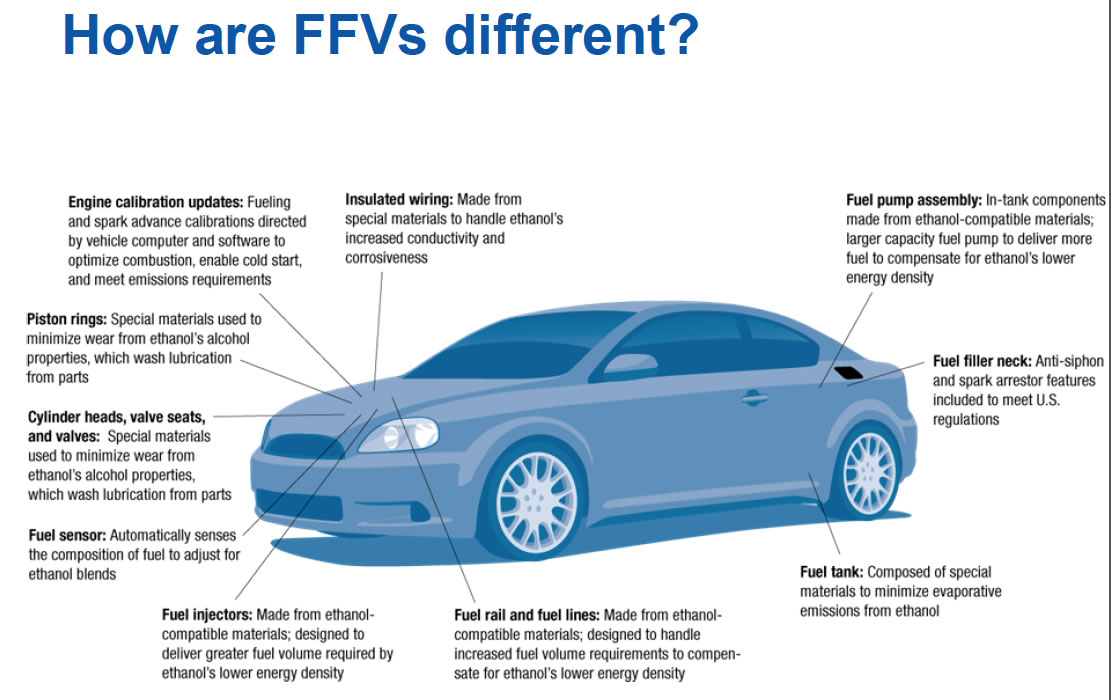
This sounds like a big deal, but as GM Vice Chancellor said in May 2011 it adds "up to $70 per vehicle".
Unlike Brazil, Flex Fuel vehicles in the US can only use anhydrous ethanol up to 85% if they are to stay under warranty.
4.4.1. Auto Racing in the US
Alcohols have proven to be great fuels for racing cars. Mike Lynch, NASCAR’s managing director of green innovation says "In emissions, we have the most visible biofuels program in the world with Sunoco Green E15, which is 15 percent American-grown, American-made ethanol, in all of our televised race cars. It’s given us higher horsepower and it’s been a real seamless transition."
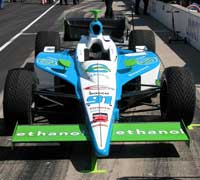
Indy 500 cars all use ethanol since 2007. Before that they used methanol.
Many other racing vehicles also use ethanol. For example this Chevy Impala, will race in NASCAR races this year. Since the program launch for the 2011 season, NASCAR drivers have run more than 3 million miles on renewable Sunoco Green E15.
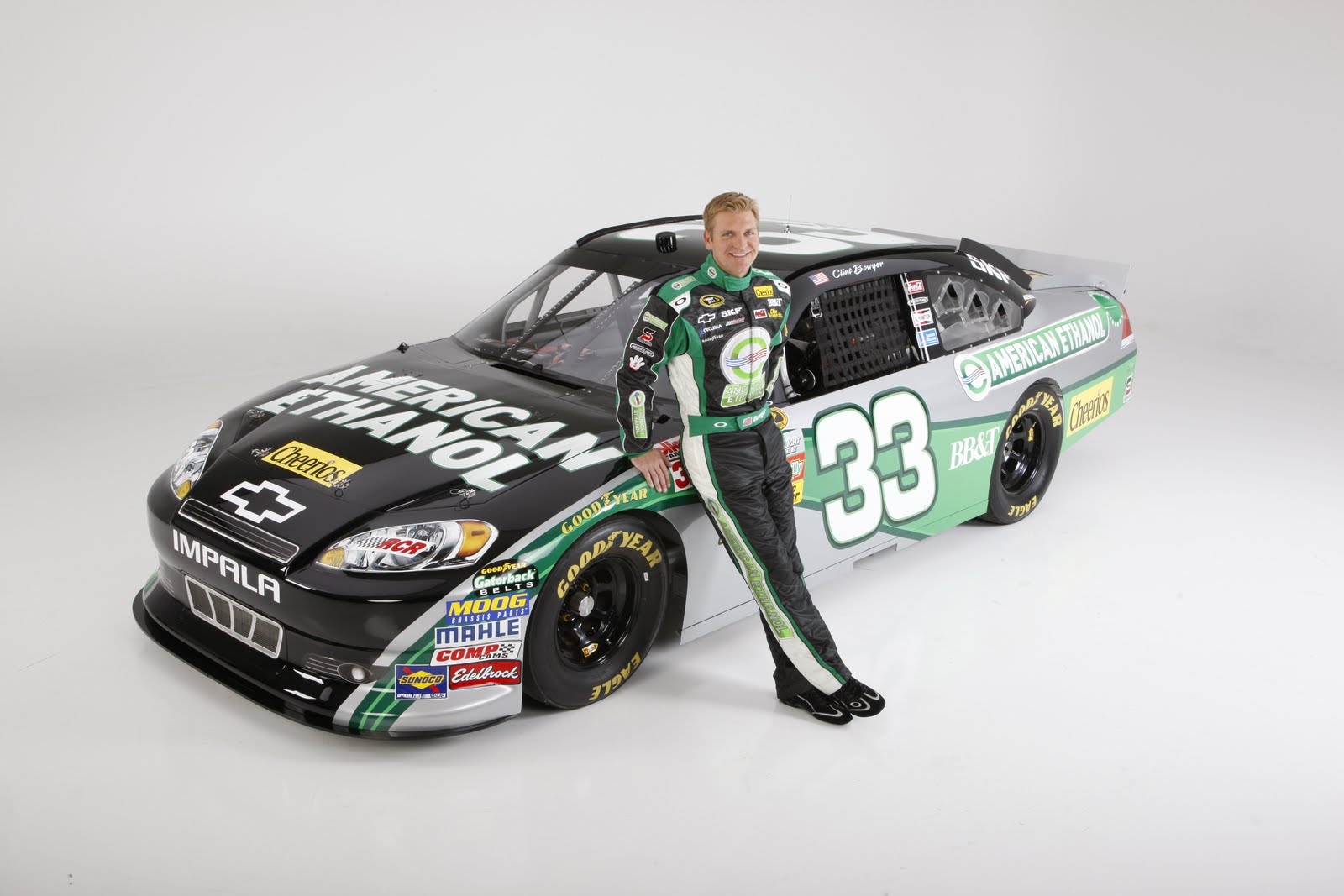
"This is stock-car racing," said Mark Reuss, president of General Motors North America. "Everything is supposed to be stock or at least as close as you can get to stock. NASCAR knew it. The sanctioning body moved to ethanol-blended fuel in 2011 and then replaced carburetors with fuel-injection systems last year.
Ford has also gotten in the act, with its E15 Fusion.
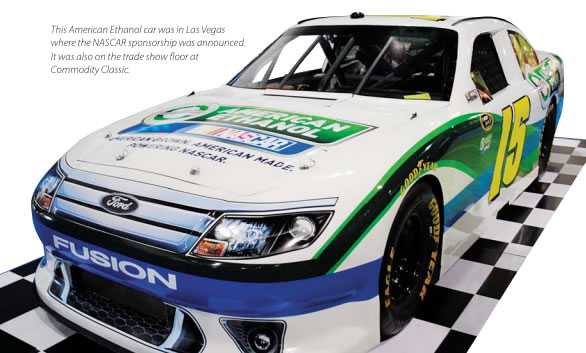
4.5. Flex fueled vehicles in Holland.
4.6. References
Brusstar and Bakenhus "Economical, high-efficiency engine technologies for alcohol fuels".
Return to Ethanol Fuels Table of Contents


